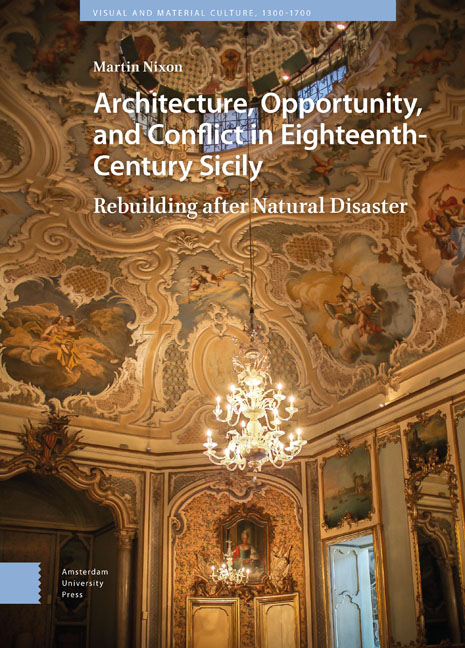 Architecture, Opportunity, and Conflict in Eighteenth-Century Sicily
Architecture, Opportunity, and Conflict in Eighteenth-Century Sicily Published online by Cambridge University Press: 24 November 2023
Abstract: The disconcerting facade sculpture of the Palazzo Beneventano in Scicli challenges expectations that decoration should beautify. Canonical classical decoration transforms into imagery of violence and fear. Monstrous faces snarl from below the balconies, and lower down there are heads of ‘Turks’ or ‘Moors’ which seem imprisoned within the building. The chapter does not promote a single reading for the decoration but relates it to the violent history of rival confraternities and aristocratic factions within Scicli, and fear of the Other. Scicli is one of Europe's most southerly towns, and even into the nineteenth century there was fear of raids by North African pirates and slavers. The facade can be read in terms of this confluence of local rivalry and broader fear.
Keywords: Mediterranean slavery, Mediterranean piracy, Italy and the Muslim world, architecture and ornament, representations of Muslims in early Modern Europe, architecture and rivalry.
Violent Decoration
In their entry for the 1754 Encyclopédie, Diderot and D’Alembert give two important principles that decoration must follow: ‘Of these four types [the decoration for facades, apartments, gardens, and theatres], that of facades is without exception the one that most taxes art's precepts. Architecture and sculpture compete equally for the [facades’] embellishment, but the latter must be absolutely subordinated to the former.’ Diderot and D’Alembert argue firstly that decoration should embellish. In their definition, facade decoration makes a palace noble, beautiful, and redolent of luxury. Secondly, decoration arises from the cooperation of sculpture and architecture. They see sculpture and architecture as distinct, but sculpture must remain subservient to architecture.
The Palazzo Beneventano in Scicli, believed to date from the 1760s, confounds these assumptions. On the palace's east facade there is sculpture of unsettling, hybrid forms. The decoration emanates an insistent sense of trauma and sadism. Monstrous fanged faces snap and snarl at the viewer from the mensole of the upper windows (Fig. 5.1). Above the lower portals of the same facade, there are grimacing heads of ‘Turks’ or ‘Moors’ (Fig. 5.2) They are not as overtly threatening as the mensole carvings of the balcony, but there is disquiet and aggression in their caricature-like quality. They appear unaware of the viewer. Imprisoned in the lower part of the building, they look up towards the owner's rooms in anticipation, captivity, or fear.
To save this book to your Kindle, first ensure no-reply@cambridge.org is added to your Approved Personal Document E-mail List under your Personal Document Settings on the Manage Your Content and Devices page of your Amazon account. Then enter the ‘name’ part of your Kindle email address below. Find out more about saving to your Kindle.
Note you can select to save to either the @free.kindle.com or @kindle.com variations. ‘@free.kindle.com’ emails are free but can only be saved to your device when it is connected to wi-fi. ‘@kindle.com’ emails can be delivered even when you are not connected to wi-fi, but note that service fees apply.
Find out more about the Kindle Personal Document Service.
To save content items to your account, please confirm that you agree to abide by our usage policies. If this is the first time you use this feature, you will be asked to authorise Cambridge Core to connect with your account. Find out more about saving content to Dropbox.
To save content items to your account, please confirm that you agree to abide by our usage policies. If this is the first time you use this feature, you will be asked to authorise Cambridge Core to connect with your account. Find out more about saving content to Google Drive.